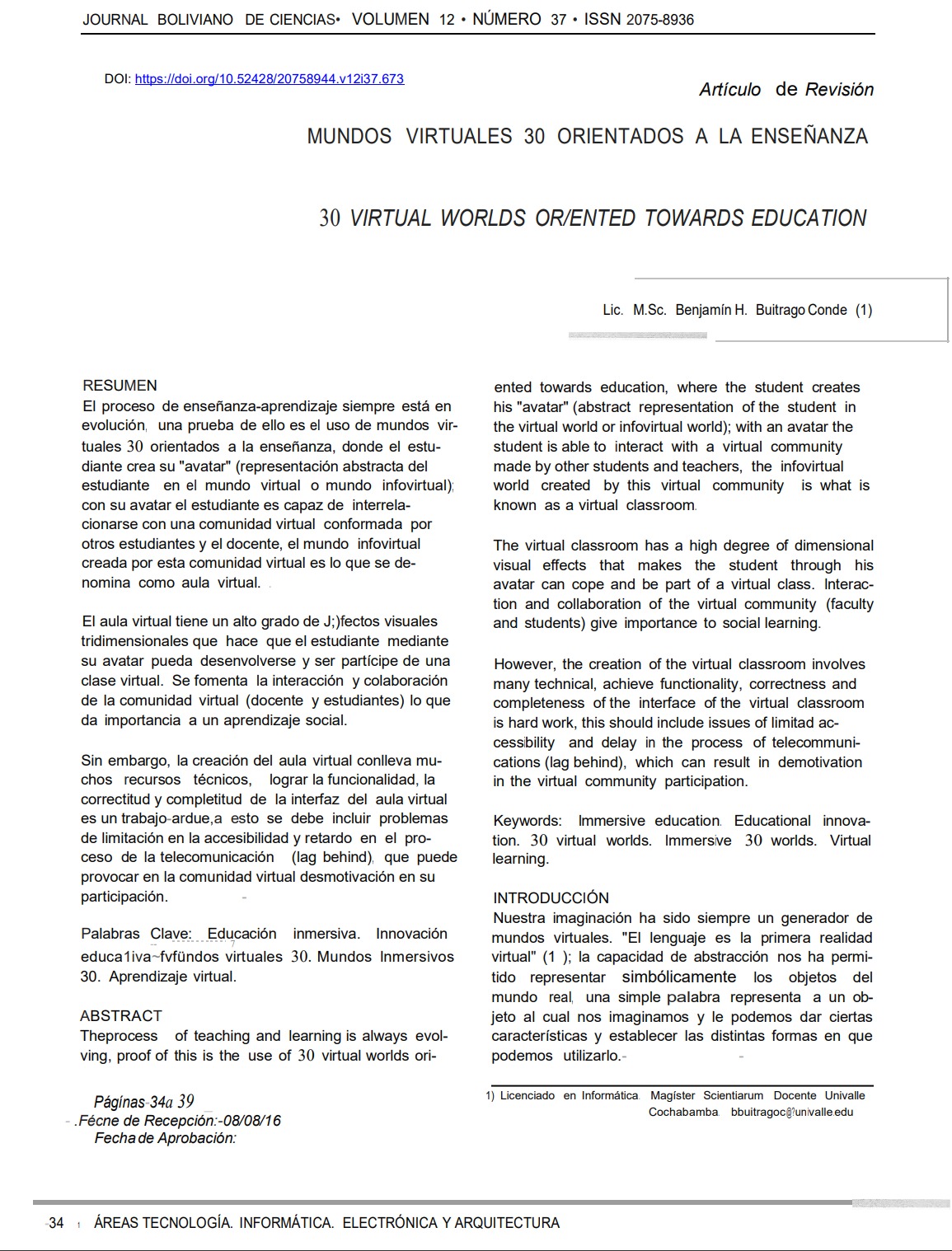30 Virtual Worlds Oriented towards Education
DOI:
https://doi.org/10.52428/20758944.v12i37.673Keywords:
lmmersive education, Educational innovation, 30 virtual worlds, Immersive 30 worlds, Virtual learningAbstract
Theprocess of teaching and learning is always evolving, proof of this is the use of 30 virtual worlds oented towards education, where the student creates his "avatar" (abstract representation of the student in the virtual world or infovirtual world). With an avatar the student is able to interact with a virtual community made by other students and teachers, the infovirtual world created by this virtual community is what is known as a virtual classroom. The virtual classroom has a high degree of dimensional visual effects that makes the student through his avatar can cope and be part of a virtual class. lnteraction and collaboration of the virtual community (faculty and students) give importance to social learning. However, the creation of the virtual classroom involves many technical, achieve functionality, correctness and completeness of the interface of the virtual classroom is hard work, this should include issues of limitad accessibility and delay in the process of telecommunications (lag behind), which can result in demotivation in the virtual community participation.
Downloads
References
(1) LÉVY, Pierre. Cibercultura. La cultura digital de la sociedad digital, Barcelona, Anthropos Editorial, Primera edición, 2007.
(2) ECHEVERRIA, Javier. Un mundo virtual, Barcelona, Plaza & Janés, Primera edición, 2000.
(3) KLASTRUP, Lisbeth . A Poetics of Virtual Worlds, Australia, http ://hypertext. rm it. ed u. au/dac/papers/KI astru p. pdf, (15 de abril de 2015)
(4) MARQUEZ, Israel. La simulación como aprendizaje: educación y mundos virtuales,España, http://www.semioteca.net/lMG/pdf/lMarquez_Simulacion.pdf, (7 de mayo de 2015).
(5) CARR, P. y POND, G. Second Lite: La guía definitiva a un nuevo mundo virtual. Barcelona, Random House Mondadori, Primera edición, 2007
(6) http://www.nytimes.com/2007/01 /07/education/edlife/07innovation.html?_r=1 &, (Fecha y hora de consulta 1 5 de abril de 2015, 20:30)
(7) http://www.sutor.com/newsite/books/buildsl/images/0301-01.jpg (Fecha y hora de consulta: 7 de mayo de 2015, 21 :00)
(8) REMOLAR, Inmaculada; CHOVER, Miguel; BELMONTE, áscar; REBOLLO, Cristina; CAMPOS, Celso. Mundos Virtuales para la Enseñanza a través de Internet, España, http://lsm.dei.uc.pt/ribie/docfiles/txt2003729192347paper-216.pdf (9 de mayo de 2015)

Downloads
Published
How to Cite
Issue
Section
License
Copyright (c) 2016 Benjamín H. Buitrago Conde

This work is licensed under a Creative Commons Attribution 4.0 International License.
Authors who publish with this journal agree to the following terms:
- Authors retain copyright and grant the journal right of first publication with the work simultaneously licensed under a Creative Commons Attribution License 4.0 that allows others to share the work with an acknowledgement of the work's authorship and initial publication in this journal.
- Authors are able to enter into separate, additional contractual arrangements for the non-exclusive distribution of the journal's published version of the work (e.g., post it to an institutional repository or publish it in a book), with an acknowledgement of its initial publication in this journal.
- Authors are permitted and encouraged to post their work online (e.g., in institutional repositories or on their website) prior to and during the submission process, as it can lead to productive exchanges, as well as earlier and greater citation of published work.














